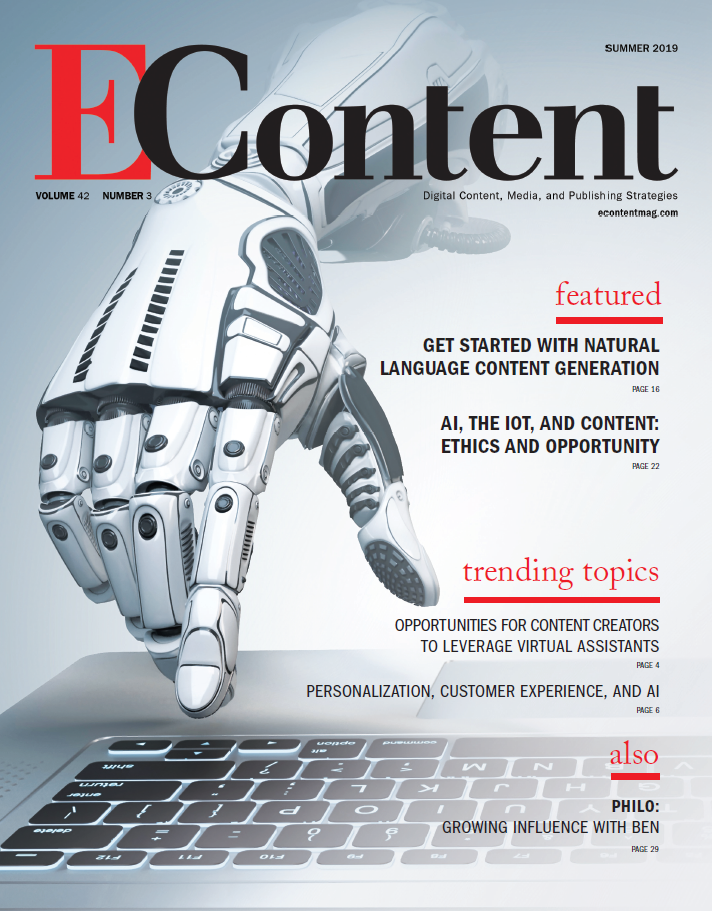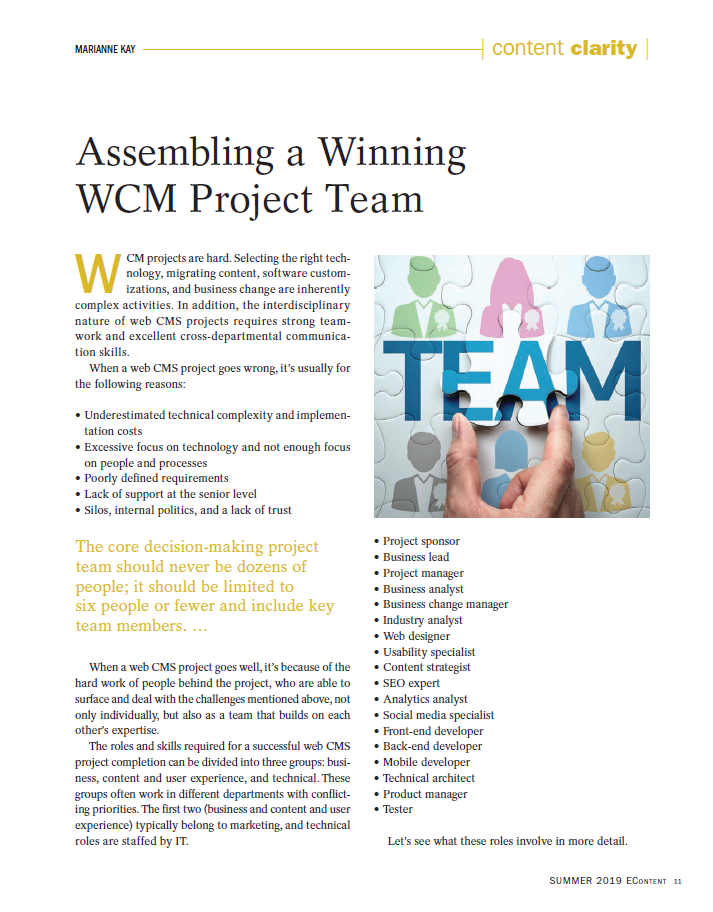The roles and skills required for a successful Web CMS project completion can be divided into three groups: business, content and technical. These groups often work in different departments with conflicting priorities. The first two (business and content) typically belong to marketing, and technical roles are staffed by IT.
When a web CMS project goes well, it’s because of the hard work of people behind the project, who are able to surface and deal with the challenges, not only individually, but also as a team that builds on each other’s expertise.
When a web CMS project goes wrong, it’s usually for the following reasons:
- Underestimated technical complexity and implementation costs
- Excessive focus on technology and not enough focus on people and processes
- Poorly defined requirements
- Lack of support at the senior level
- Silos, internal politics, and a lack of trust
When a web CMS project goes well, it’s because of the hard work of people behind the project, who are able to surface and deal with the challenges mentioned above, not only individually, but also as a team that builds on each other’s expertise.
The roles and skills required for a successful web CMS project completion can be divided into three groups: business, content and user experience, and technical. These groups often work in different departments with conflicting priorities. The first two (business and content and user experience) typically belong to marketing, and technical roles are staffed by IT.
- Project sponsor
- Business lead
- Project manager
- Business analyst
- Business change manager
- Industry analyst
- Web designer
- Usability specialist
- Content strategist
- SEO expert
- Analytics analyst
- Social media specialist
- Front-end developer
- Back-end developer
- Mobile developer
- Technical architect
- Product manager
- Tester
Let’s see what these roles involve in more detail.
Business
Project sponsor secures funding and provides executive-level support for the project. This position is the living proof that the project is recognized as strategic to the business.
Business lead ensures that the project aligns with the overall business strategy and is the voice of the business users (usually, content editors and marketing staffers).
Project manager is responsible for planning, monitoring, and closing the project. He or she ensures that what is delivered is right for the business and prevents the project from becoming a never-ending series of scope creep. Being able to afford a project manager on a small content management project can be a luxury, but large organizations with web CMS project teams of 10 people or more significantly improve the chances of successful delivery with a dedicated project manager on board.
Business analyst defines, analyzes, and documents requirements. Without a business analyst, WCM projects end up delivering against a laundry list of nice-to-haves that are poorly defined, poorly prioritized, or both.
Business change manager facilitates change to business processes, systems, and technology, often through modifying job roles and organizational structures. Change is hard; new systems and processes take time to learn. Unmanaged change can lead to the premature deconstruction of deliverables before they even start to bring business benefits.
Industry analyst is invaluable if the project includes a web CMS selection and procurement. Organizations tend to select new technology every 5–7 years, while industry analysts deal with web CMS selections every day, so it is wise to source this expertise externally.
Content and User Experience
Web designer—once the initial concept is designed and signed off on—works closely with front-end developers to build a design patterns library for a wide range of use cases and devices. The BBC’s Global Experience Language (GEL) is one great example of such a library.
Usability specialist is responsible for continuous data-driven improvements. A usability specialist can also help to prototype proposed solutions and evaluate them from the user experience angle.
Content strategist organizes content and manages content writers, recognizing content as a business asset. A good content strategist scrutinizes every webpage, asking, “What should this page make you think, feel, or do?” If it’s not working toward the business goals, it has to be rewritten or removed.
SEO expert minimizes the impact of the technology change and content migration on search engine visibility. Writing good content is always a good basic approach to SEO, but at the time of significant technical change, special attention is a must.
Analytics analyst informs some of the prioritization and decision making of the CMS project, as it is also important for measuring the project’s success.
Social media specialist is involved in communicating change to the customers after the launch of the new site.
Technical
Front-end developer’s role is becoming increasingly challenging due to the constant evolution of technologies and proliferation of devices (including mobile). Maintaining a stable front-end codebase requires more than just the knowledge of HTML, CSS, and JavaScript. It also requires appreciation of software engineering principles in a broader sense.
Back-end developer for a web CMS project should have previous experience of working with the chosen system. In the absence of this, experience with similar enterprise-level CMSs can be sufficient.
Mobile developer is desirable for managing complexity that the responsive web design brings, and it’s a must for projects that include native mobile apps.
Technical architect or enterprise architect takes care of the bigger-picture technical implementation issues such as systems integrations, servers, security, hosting, and bandwidth.
Product manager is necessary when the need for the web CMS customizations is so high that the customized platform effectively becomes a software product in its own right. Some media and higher education organizations (such as the BBC, The Guardian, and the University of Edinburgh) go down this highly customized route. The product manager protects the system from the feature bloat and ensures long-term maintainability.
Tester in software development ensures higher standards and better user experience. For large-scale projects, a separate testing team is vital.
Team Size
In a small company with limited resources and budget, some of the roles can be combined. For example, a business lead could take on project management and business analysis tasks, as well as be responsible for driving business change. A web developer can be a full-stack developer responsible for front end, back end, mobile development, security, and testing. A web designer can take on usability as part of this role. A content editor can be responsible for content strategy, content writing, SEO, and social media.
Large organizations that can afford to hire individual staffers for each role benefit from high-quality, specialized expertise. At the same time, the larger the team, the more effort it takes to keep people organized and productive. Some web CMS projects go over time and over budget due to excessive time spent in committee-type meetings that lead the project nowhere. The core decision-making project team should never be dozens of people; it should be limited to six people or fewer and include key team members: a project sponsor, a business lead, a project manager, a technical lead, and a content lead.
Senior vs. Junior Roles
Completing a web CMS project requires a lot of knowledge and experience. That said, there is also a lot of tedious lifting and shifting along the way that would benefit from the energy and enthusiasm of junior-level staffers. Experienced CMS specialists are harder to find and easier to lose than junior colleagues. As with any other project, a mix of junior-level and experienced staffers is key to success.
Conclusion
Every WCM project requires business, content, and technical skills. If you break these broad categories of skills down into specialist roles, it may seem like a lot of people. However, not all roles require a separate dedicated resource, and many can be covered by someone already employed by your marketing, communications, or IT department. The gaps in skills can then be filled by recruiting permanent staff in-house, employing a contractor, or partnering with a digital agency.


